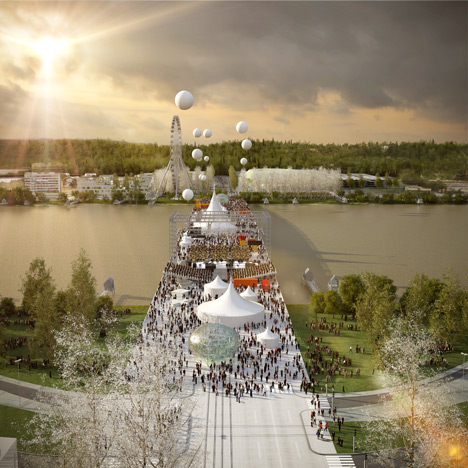News: a proposal by Rem Koolhaas' firm OMA for a bridge that could accommodate different types of traffic as well as pedestrians and events has been selected by local authorities in Bordeaux, France, as one of two final competing designs.
The proposed design aims to "rethink the civic function and symbolism of a twenty-first century bridge" by creating a platform traversing the river Garonne that could be used by cars, trams, buses, bicycles and pedestrians.
A wide boulevard with a gentle gradient would make the bridge easy to walk across and allow it to be used to host events.
OMA project leader Clement Blanchet said the studio wanted to "provide the simplest expression – the least technical, least lyrical, an almost primitive structural solution. This simplicity allowed us to create a generous platform for pedestrians and public programs, as well as flexibility in accommodating the future needs of various types of traffic."
Either OMA or French firm Dietmar Feichtinger will be awarded the project in December this year, with completion scheduled for 2018.
Yesterday, Thomas Heatherwick unveiled a design for a pedestrian bridge housing a garden to span the River Thames in London.
OMA is up against Danish firm BIG in a competition to redevelop the site of a convention centre in Miami.
In a movie filmed in Milan as part of our Dezeen and MINI World Tour, journalist Justin McGuirk described OMA's Tools for Life collection of furniture as a nostalgic statement about the decline of industry in the city.
See all stories about OMA »
See all stories about bridges »
Images copyright OMA unless otherwise stated.
Here's some more information from OMA:
OMA leads the final round for Pont Jean-Jacques Bosc international competition in Bordeaux
OMA's design for a new bridge across the river Garonne in Bordeaux has been selected as one of two final competing projects by the city authorities. OMA's stripped-down design for the Pont Jean-Jacques Bosc attempts to rethink the civic function and symbolism of a 21st century bridge.
Clement Blanchet, leading the project for OMA with Rem Koolhaas said: "The bridge itself is not the 'event' in the city, but a platform that can accommodate all the events of the city. We wanted to provide the simplest expression – the least technical, least lyrical, an almost primitive structural solution. This simplicity allowed us to create a generous platform for pedestrians and public programs, as well as flexibility in accommodating the future needs of various types of traffic."
Vincent Feltesse, president of Urban Community of Bordeaux made the decision with the deliberation of a jury of 40 people, announcing that the municipality wanted something "bold."
Beyond traditional fascinations with style and technical performance, OMA tried to design a 21st century bridge that exploits state-of-the-art techniques in order to create a contemporary boulevard. A platform 44 metres wide and 545 metres long is stretched beyond the water on either side, creating a seamless connection with the land. The bridge slopes gently, allowing an easy promenade while still giving necessary clearance for boats underneath. Each type of traffic – cars, RBD (tram/bus), bicycles – has its own lane, and is designed to meet changing vehicular needs. By far the largest strip is devoted to pedestrians.
The bridge is designed to cohere with the adjacent St. John Belcier urban redevelopment project. It also attempts to unify the different conditions of the two banks of the Garonne: from the Right Bank, strictly aligned on a poplar-lined meadow, to the urban landscape of the Left Bank, it aims solve the dual challenge of aura and performance in an environment steeped in history.
A final decision between designs by OMA and Dietmar Feichtinger will be made in December this year, with the bridge scheduled for completion in 2018.
The project is developed in collaboration with engineers WSP, the landscape architect Michel Desvigne, as well as the consultant EGIS and light design agency Lumières Studio.

